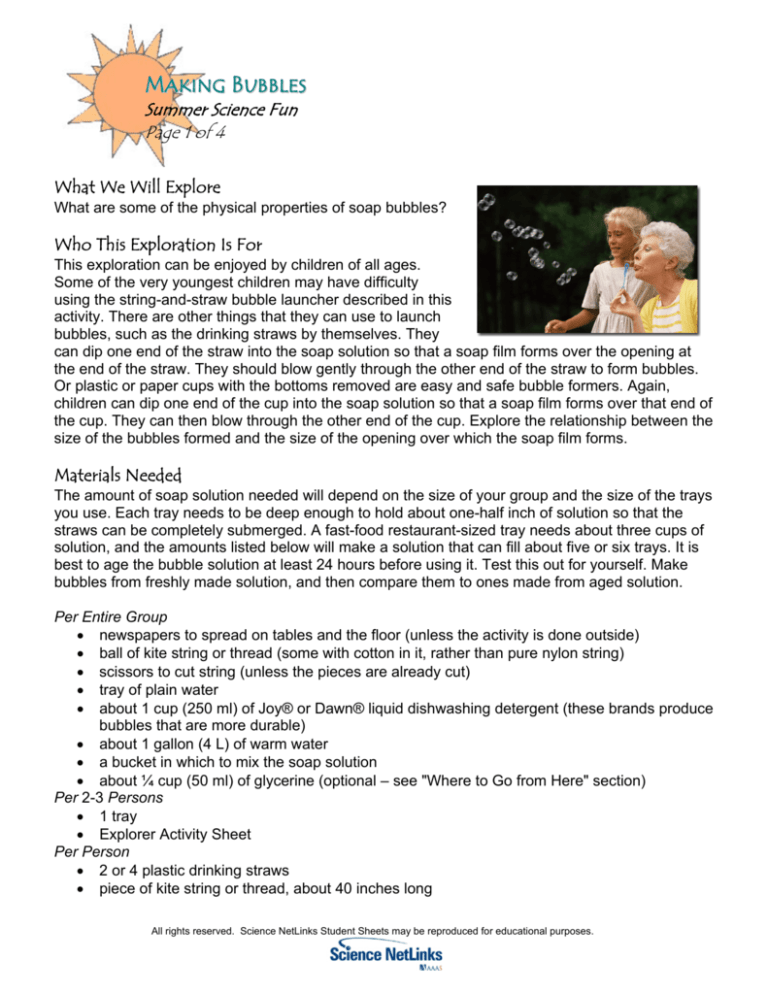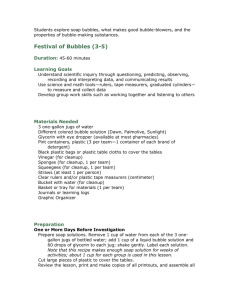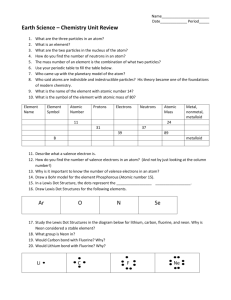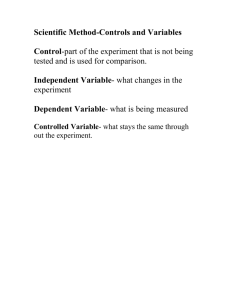
Making Bubbles
Summer Science Fun
Page 1 of 4
What We Will Explore
What are some of the physical properties of soap bubbles?
Who This Exploration Is For
This exploration can be enjoyed by children of all ages.
Some of the very youngest children may have difficulty
using the string-and-straw bubble launcher described in this
activity. There are other things that they can use to launch
bubbles, such as the drinking straws by themselves. They
can dip one end of the straw into the soap solution so that a soap film forms over the opening at
the end of the straw. They should blow gently through the other end of the straw to form bubbles.
Or plastic or paper cups with the bottoms removed are easy and safe bubble formers. Again,
children can dip one end of the cup into the soap solution so that a soap film forms over that end of
the cup. They can then blow through the other end of the cup. Explore the relationship between the
size of the bubbles formed and the size of the opening over which the soap film forms.
Materials Needed
The amount of soap solution needed will depend on the size of your group and the size of the trays
you use. Each tray needs to be deep enough to hold about one-half inch of solution so that the
straws can be completely submerged. A fast-food restaurant-sized tray needs about three cups of
solution, and the amounts listed below will make a solution that can fill about five or six trays. It is
best to age the bubble solution at least 24 hours before using it. Test this out for yourself. Make
bubbles from freshly made solution, and then compare them to ones made from aged solution.
Per Entire Group
• newspapers to spread on tables and the floor (unless the activity is done outside)
• ball of kite string or thread (some with cotton in it, rather than pure nylon string)
• scissors to cut string (unless the pieces are already cut)
• tray of plain water
• about 1 cup (250 ml) of Joy® or Dawn® liquid dishwashing detergent (these brands produce
bubbles that are more durable)
• about 1 gallon (4 L) of warm water
• a bucket in which to mix the soap solution
• about ¼ cup (50 ml) of glycerine (optional – see "Where to Go from Here" section)
Per 2-3 Persons
• 1 tray
• Explorer Activity Sheet
Per Person
• 2 or 4 plastic drinking straws
• piece of kite string or thread, about 40 inches long
All rights reserved. Science NetLinks Student Sheets may be reproduced for educational purposes.
Making Bubbles
Summer Science Fun
Page 2 of 4
Safety Considerations
•
•
If this is done indoors on an uncarpeted floor, spread newspapers on the floor so that it
does not become dangerously slippery from spilled soapy water. Have children stop
occasionally to wipe up soapy water that spills on the floor.
Normal care should be taken when using scissors. Younger explorers should probably use
blunt scissors.
Adaptations for Participants with Disabilities
•
•
•
Participants with hearing impairments should be able to do this activity without any
modifications other than those necessary to communicate instructions.
Be careful of sharp edges on some of the alternative bubble launchers listed below.
Participants with mobility impairments who would have difficulty using the straw-string
bubble maker might be able to use alternatives such as plain straws, soup cans, or slotted
spoons.
Curiosity Starter
Ask your explorers what they know about bubbles and where they've seen them. You'll probably
find that the responses include soap bubbles (in the sink or bathtub and blown in the air), bubbles
in soft drinks (rising in the liquid and as foam on top), bubbles in boiling water, and bubble-gum
bubbles. Take two clear bottles, one half-filled with water and the other half-filled with soap
solution. Shake both bottles a few times and set them down for the explorers to observe. Ask
explorers: What happens in each case? Why do the few bubbles in the water quickly disappear,
while the bubbles (suds) in the soap remain for a long time? How can we explore the properties of
soap solutions?
What to Do
Materials Preparation
• Add 1 cup (250 ml) of Dawn® or Joy® to 1 gallon (4 L) of water.
• The bubble solution produces more films and bubbles if it ages for a while. Time for aging
can be anywhere from half an hour to several days. If you have the time and facilities, age
the bubble solution at least overnight.
• For younger children, you may want to cut the pieces of string ahead of time.
• Arrange a large, open area for doing this activity. Since soapy water will be likely to splatter,
it is a good idea to do this activity outdoors on a calm, warm day.
To Prepare for Next Time
• Soap solution can be safely poured down a drain for disposal. However, we suggest you
save your soap solution in a gallon jug; it can be reused. Store it in a cool spot in a
storeroom, garage, or basement. Label it clearly!
• Rinse and dry all trays and bowls thoroughly. The trays must be thoroughly rinsed so that no
soap residue remains, because during the first part of the student exploration, students blow
bubbles into fresh water.
All rights reserved. Science NetLinks Student Sheets may be reproduced for educational purposes.
Making Bubbles
Summer Science Fun
Page 3 of 4
•
String-and-straw bubble launchers probably cannot be reused after the string dries.
However, the straws can be reused with new string. If you wish to save the straws for reuse,
rinse them out.
Guiding the Exploration
(See also the questions throughout the Activity Sheet.)
To begin the exploration, fill up a clean tray or bowl with water and have students take turns trying
to blow bubbles in the water with their straws. Then, have them fill up their trays with soap solution
and compare the bubbles that they have blown with the two solutions. From this point on, student
groups can work on their own, guided by the activity sheet. As you interact with the groups, use the
following questions to help guide the explorations:
•
•
•
•
•
•
•
•
How would you describe the shape of a soap bubble?
Do bubbles always fall to the ground? Why?
Do bubbles float on water?
Who can blow the smallest bubble? The largest bubble? Describe the techniques that you
used.
When launching the giant soap bubbles, what kinds of bubble shapes do you see? Does the
soap film usually pull itself together into round shapes, sometimes coming close to the
shape of a sphere or ball? Can you launch a bubble shaped like a cube, that is, with square
comers? Why, or why not?
Can you hold a bubble in your hand? Can you put your hand into a large bubble without
breaking the bubble? How?
Can you blow a bubble inside another bubble?
How do things appear when you look through a bubble? Describe what you see.
Where to Go from Here
•
•
•
•
You also might ask explorers to try to form a ring by holding their thumbs and forefingers
together. Then they can dip their hands into the soap solution to form a soap film from which
they can blow bubbles. Other good bubble makers include funnels, tops from 2-liter bottles,
paper or plastic cups with the bottoms cut out, the plastic rings that hold six-packs of soda
together, and plastic paper-plate holders that have holes in the bottom.
Does the temperature of the bubble solution make a difference? Have students design an
exploration to find this out.
Will adding glycerine to the soap solution have any effect on the bubbles? Have students
design an exploration to find out. If the glycerine bubbles last longer or not as long, have
students find out why.
For more activities, check out the following books: Exploratopia by Pat Murphy, Ellen
Macaulay, and the staff of the Exploratorium; Thomas Edison for Kids by Laurie Carlson;
and Soap Science by J. L. Bell.
All rights reserved. Science NetLinks Student Sheets may be reproduced for educational purposes.
Making Bubbles
Summer Science Fun
Page 4 of 4
Why It Happens
Water particles, or molecules, attract one another and create a tension in the water's surface that
pulls all of the water particles together into the smallest shape possible. That shape, for a falling
water drop, or in this case, a bubble, is a sphere.
The tight surface of water, however, can be stretched. You can see this stretchiness if you place
one end of a straw beneath the surface of water in a bowl and blow gently through the other end,
as in the first part of this activity. The air that you blow stretches the flat surface upward into a
dome-shaped liquid film. Although the water surface can be stretched, the stretchiness is limited.
The bubbles that you can form in plain water with the straw do not last very long. They break
almost immediately because of the tension in the surface of the water. The molecules in the
surface are pulling together so tightly that they break the film before the bubbles get very big.
However, the stretchiness of the water's surface is increased by adding soap or detergent to the
water. These ingredients cause the pulling force of tension in the water surface to become weaker,
so that the water pulls itself into nice rounded drops when sitting on a flat surface. As in our earlier
illustration with the straw, if you blow through a straw into a dish of soapy water, the bubbles that
are forced upward by the air now last much longer. The surface of the water still has a pulling
force, but the force is much weaker than it was without soap. That means that the water surface
can stretch much more without breaking, and you get bubbles that are bigger and last longer.
What causes the soap to have this effect on surface tension? It has to do with the chemical
structure of both the water and the soap. In a soap bubble or a flat soap film, the soap molecules
and water molecules distribute themselves like layers in a sandwich, with an inside "filling" of water
molecules covered by two outside layers of soap molecules. This is because of the way that soap
molecules interact with water molecules. A soap molecule can be pictured as a snake, with a
"head" attached to a long "tail." The "head" end of the soap molecule is attracted to the water, and
the "tail" end is not. In a bubble, the soap molecules that are near the surface of the film push their
water-repelling ends out into the air, squeezing between water molecules and shoving them apart
to do so. The attraction between water molecules, which make water have such high surface
tension, decreases in strength as the distance between the water molecules increases. By
separating the molecules at the surface, soap molecules decrease the water's "stickiness" and its
surface tension.
The "tail" of a soap molecule is attracted to grease, dirt, and oils, which is why soap is a good
cleaning agent. One end attracts and holds onto the grease particles, while the other end holds
onto water molecules. When you rinse the soap off of your dirty plate, the rinse water pulls on the
water-attracting end of the molecules, and these molecules pull on the grease with their other
ends, thus pulling it off your dishes.
Finally, you might wonder why soap bubbles pop. The water "filling" between the two soap layers
runs down the sides of the bubble until the top of the bubble is very thin, and then it pops!
All rights reserved. Science NetLinks Student Sheets may be reproduced for educational purposes.






